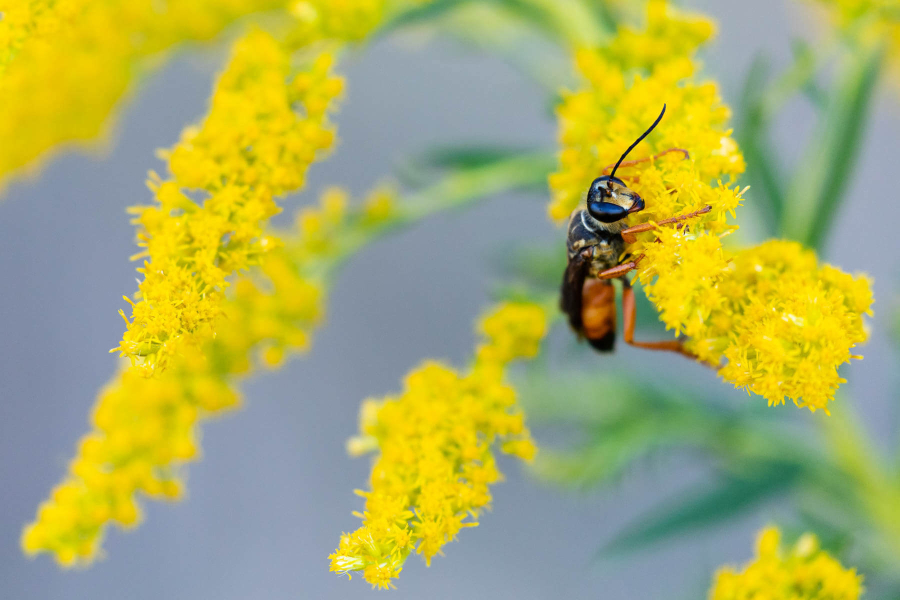How to use your yard to save birds and bugs

Insects are in sharp decline in the Chesapeake region and beyond, and right alongside them are the birds. While there are many factors putting these species in danger, their declines are also correlated: most birds feed on insects, so fewer insects often lead to fewer birds.
It takes over 6,000 caterpillars to feed a single clutch of chickadee babies, and over 80% of the hummingbird's diet relies on insects and spiders. The beloved Eastern bluebird feeds on caterpillars, beetles, crickets, grasshoppers and spiders, as do many other birds that live in and visit the watershed.
But both birds and insects also need one other thing to thrive: plants. And that’s where we, the humans, come in.
The power in your backyard
According to a study published in the journal Environmental Management, over 40 million acres of land in the continental United States has some form of lawn on it, making grass the largest irrigated crop in the country. If we used some of that lawn for strategically-selected plants, this could be a world of new, suitable habitat for insects and birds.
Of course, not just any plant will do. Birds and bugs can be as picky as Goldilocks and will only live in an area that has special types of plants. Research continues to show that native plants are needed to sustain our local bird and insect species. As their name entails, native species are, well, native to a particular region. They have evolved within the ecosystem and therefore thrive in the soil and weather of that area and most importantly, are connected to other organisms who depend on them for their survival.
A good example is how native flowering plants, which grow and spread through pollination, have evolved alongside native pollinators and therefore pollinate more effectively when paired with them. A native insect’s leg shape or size of their mouthparts can be perfectly adapted to a native plant’s shape, making it easier to access the pollen. Likewise, the flower color of those plants can be adapted to specifically attract native insects. And while native species have the ability to adapt to new, “non-native” wildlife overtime, the introduction of non-natives and disappearance of natives is happening too quickly for the ecosystem adjust.
Similarly, many native plants also function as “host plants,” which are species that a wide variety of wildlife depend on. Goldenrod, for example, is needed to sustain thirteen species of insects local to the Bay region and supports an additional 105 species. The Great Spangled Fritillary Butterfly feeds on a variety of plants, like bee balm, asters, milkweed, bergamot and passion flowers, but the caterpillar form of this butterfly is strictly dependent on violets. Without their host plants, many local insects will suffer, followed by the birds and other large mammals.
How to get started
So, how can you use your yard to create better habitats for birds, insects and pollinators? Start by finding out which native plants should be planted in your region. Here are three great resources to use.
- The National Wildlife Federation’s Plant Finder
- Native Plant Center
- U.S. Department of Agriculture Plant Database
You can also become an expert yourself by joining a Watershed Steward, Master Naturalist or Master Gardener program. These programs are offered all throughout the Chesapeake Bay watershed.
If you have access to a decently-sized yard or property, then consider contacting a conversation landscape professional, like a Chesapeake Bay Landscape Professional here in the watershed, and have them design a native-plant pollinator garden for your area. These individuals are trained to understand, install and maintain sustainable landscaping.
Don’t have access to a green space? There are plenty of other ways you can help native species. Most importantly, be vigilant in making sure you do not contribute to the spread of non-native species.
To learn more about the role the native plants play in serving our bird and insect populations, check out our latest webinar featuring plant and wildlife specialists from the Chesapeake Bay Program.

Comments
Wonderful article. I shared this one with my grandson. Also, thank you for your mention and link to the Chesapeake Bay Landscape Professionals. Also, it is so nice to have the opportunity to share with the author! Have a great rest of your week, Janit Llewellyn
Very interesting article, Jake. My wife loves to garden here in Roanoke & is always interested in providing for the native birds & insects. I/we will follow the links provided to learn what we can do to provide a healthy environment for the critters we cherish. Thank you for the work that you do.
Dave & Cindy
Thank you!
Your comment has been received. Before it can be published, the comment will be reviewed by our team to ensure it adheres with our rules of engagement.
Back to recent stories